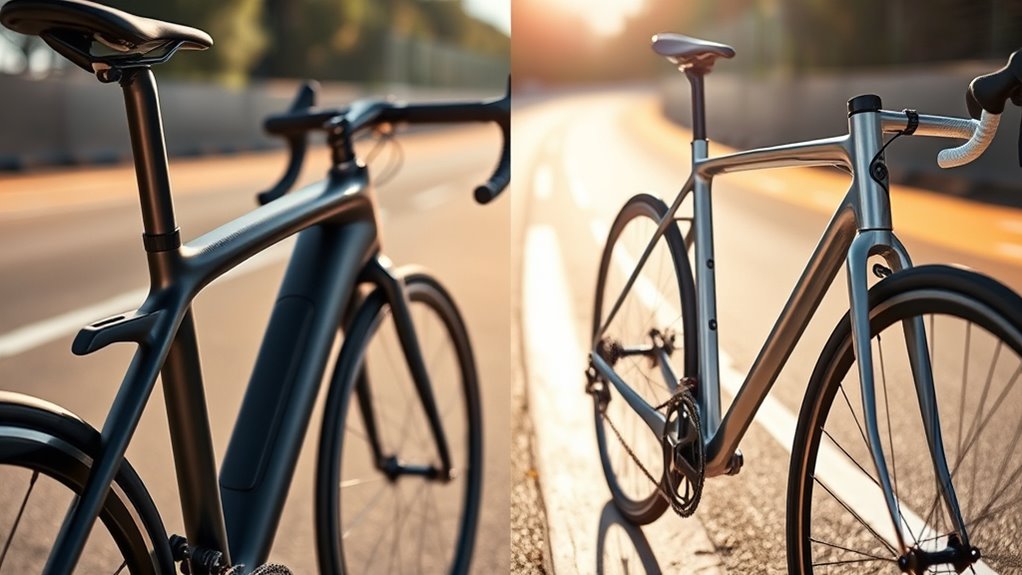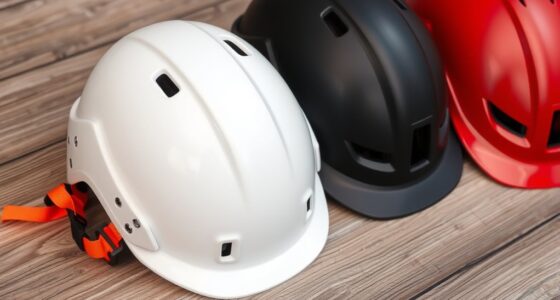When deciding between aero and lightweight components, consider your riding environment and goals. If you race on flat, smooth roads, aero parts help you cut through the air faster. For climbs, rough terrain, or endurance rides, lightweight setups make pedaling easier and handling more comfortable. Both choices impact durability and ride quality, so your focus determines what matters most. Want to understand how to balance these options for your rides? Keep exploring to find out more.
Key Takeaways
- Flat, smooth terrains benefit more from aero components for speed and efficiency.
- Climbing and rough terrain favor lightweight parts for easier handling and reduced effort.
- Aero setups excel in racing scenarios with minimal hazards, where air resistance is critical.
- Lightweight components improve comfort and durability on long, varied, and technical rides.
- Balancing aero and lightweight features depends on terrain, ride goals, and environmental conditions.

When choosing between aero and lightweight components, it’s essential to understand how each impacts your bike’s performance. Both factors influence different aspects of your ride, and the right choice depends on your riding style, terrain, and goals. Aero components prioritize reducing air resistance, helping you go faster on flat or rolling terrain. Lightweight parts, on the other hand, focus on minimizing weight, making climbs easier and improving handling in technical sections. Recognizing which element matters more in your riding context can elevate your performance and enjoyment.
One key consideration when selecting components is frame stiffness. Aero frames often feature a stiffer structure to reduce flex and improve power transfer, especially at high speeds. This stiffness translates to more efficient energy use, allowing you to maintain momentum with less effort. However, increased frame stiffness can sometimes lead to a harsher ride, particularly on rough surfaces, which might cause fatigue over long distances. Conversely, lightweight frames tend to be less stiff, offering a more compliant feel that absorbs road vibrations better. If you value comfort and smoothness, especially on bumpy roads or longer rides, a lightweight frame might serve you better, even if it sacrifices some aerodynamic efficiency.
Frame stiffness affects ride comfort and efficiency, balancing power transfer with ride smoothness depending on your terrain and preferences.
Tire durability is another critical factor influenced by your component choice. Aero wheels and frames often have narrower, more aerodynamic tires that cut through the air but may compromise on durability and traction. These tires are typically designed for speed and efficiency rather than longevity, meaning you’ll need to replace them more frequently if you ride aggressively or on rougher surfaces. Lightweight setups, however, usually incorporate slightly wider and more durable tires that can withstand rougher terrain and extended use without frequent replacements. This durability is advantageous if your rides include gravel, mountain trails, or urban environments where tires encounter more hazards. Additionally, the development of advanced tire materials has improved the durability-to-weight ratio, benefiting both aero and lightweight configurations.
Ultimately, your decision should align with your riding environment and objectives. If you mainly race on flat courses with smooth pavement, prioritizing aero components makes sense—they’ll help you shave seconds off your time. But if your rides involve climbing, rough roads, or long endurance efforts, lightweight components with more tire durability and a comfortable frame stiffness profile might serve you better. Balancing these factors ensures your bike meets your specific needs, maximizing efficiency, comfort, and durability. Understanding how frame stiffness and tire durability intertwine with your component choices helps you make smarter decisions, ensuring you get the most out of every ride.
Frequently Asked Questions
How Does Weather Affect Aero Versus Lightweight Performance?
Weather notably impacts aero efficiency and weather adaptation. When it’s windy, you benefit from more aero-focused gear to cut through gusts, improving your performance. Rain or cold temperatures require gear that adapts well to weather conditions, so lightweight options might struggle in harsh weather. You should choose your gear based on weather, prioritizing aero efficiency in calm conditions and weather adaptation when facing challenging elements.
Which Is More Important for Beginner Riders?
As a beginner rider, lightweight bikes often matter more because they’re easier to handle and maneuver. While aero features can boost speed, they might add complexity or weight that isn’t necessary initially. Your preferences should focus on comfort and ease of riding. Once you gain experience, then considering aero vs lightweight options can help you optimize performance based on your riding goals.
Can Bike Maintenance Impact Aero or Lightweight Benefits?
Bike maintenance can definitely impact aero and lightweight benefits. If you neglect regular upkeep, your frame’s durability may suffer, leading to potential damage that reduces your bike’s efficiency. Poor maintenance can also increase costs over time, especially if you need to replace parts prematurely. Keeping your bike well-maintained ensures that both aero features and lightweight design work *effectively*, helping you ride faster and more smoothly without unnecessary expenses.
How Do Terrain Types Influence Aero and Lightweight Choices?
Terrain impact plays a big role in your choice between aero and lightweight bikes. For hilly or mountainous routes, a lightweight bike helps you climb easier and conserve energy. On flatter, wind-exposed terrains, aero bikes reduce drag and boost speed. Your riding style also matters—if you prefer fast sprints or long climbs, pick accordingly. Ultimately, matching your terrain and riding style guarantees you get the most out of your bike choice.
Are There Safety Concerns With Lightweight Bike Frames?
Sure, lightweight frames might seem delicate, but they’re often made from safe, durable materials like carbon fiber or aluminum. The irony is, while they’re praised for speed, some worry about frame durability. Rest assured, if you choose reputable brands, material safety and frame integrity are prioritized. Just avoid crashes, and your lightweight bike remains safe. So, yes, safety concerns are minimal when you select quality, well-designed frames.
Conclusion
Ultimately, whether you prioritize aero or lightweight depends on your riding goals. Remember, “a chain is only as strong as its weakest link,” so choose what complements your style best. If speed is your aim, aero might give you the edge. But if conquering climbs is your focus, a lightweight frame could serve you better. Know that, like a boat needs both sail and rudder, balancing these factors will steer you toward success on every ride.








